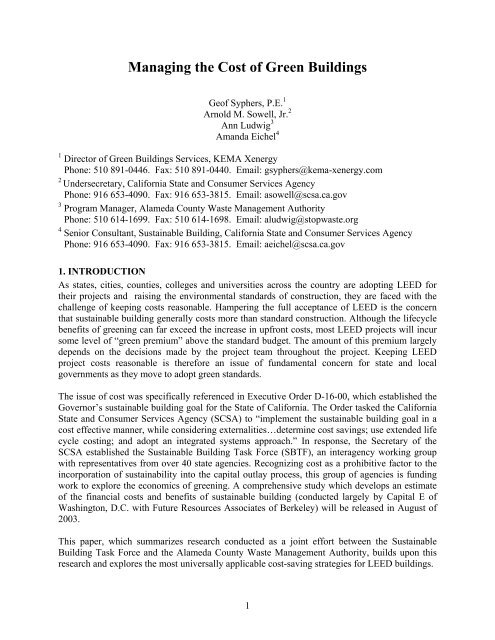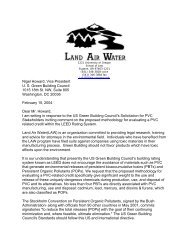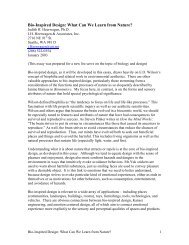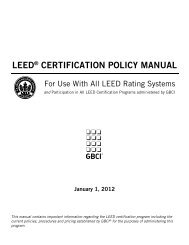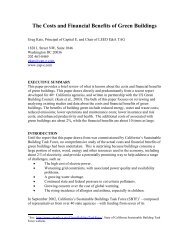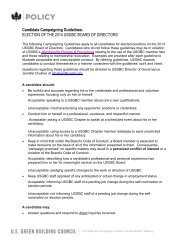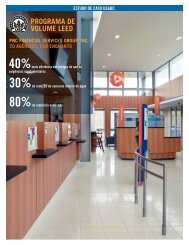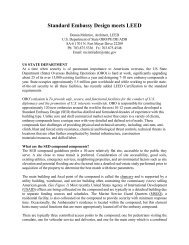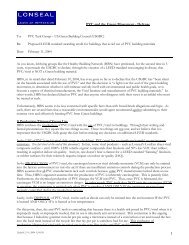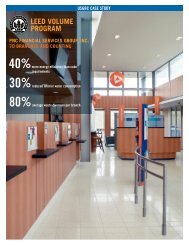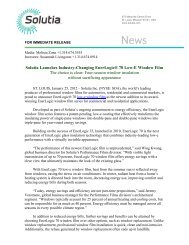Managing the Cost of Green Buildings - US Green Building Council
Managing the Cost of Green Buildings - US Green Building Council
Managing the Cost of Green Buildings - US Green Building Council
You also want an ePaper? Increase the reach of your titles
YUMPU automatically turns print PDFs into web optimized ePapers that Google loves.
<strong>Managing</strong> <strong>the</strong> <strong>Cost</strong> <strong>of</strong> <strong>Green</strong> <strong><strong>Building</strong>s</strong><br />
Ge<strong>of</strong> Syphers, P.E. 1<br />
Arnold M. Sowell, Jr. 2<br />
Ann Ludwig 3<br />
Amanda Eichel 4<br />
1 Director <strong>of</strong> <strong>Green</strong> <strong><strong>Building</strong>s</strong> Services, KEMA Xenergy<br />
Phone: 510 891-0446. Fax: 510 891-0440. Email: gsyphers@kema-xenergy.com<br />
2<br />
Undersecretary, California State and Consumer Services Agency<br />
Phone: 916 653-4090. Fax: 916 653-3815. Email: asowell@scsa.ca.gov<br />
3 Program Manager, Alameda County Waste Management Authority<br />
Phone: 510 614-1699. Fax: 510 614-1698. Email: aludwig@stopwaste.org<br />
4 Senior Consultant, Sustainable <strong>Building</strong>, California State and Consumer Services Agency<br />
Phone: 916 653-4090. Fax: 916 653-3815. Email: aeichel@scsa.ca.gov<br />
1. INTRODUCTION<br />
As states, cities, counties, colleges and universities across <strong>the</strong> country are adopting LEED for<br />
<strong>the</strong>ir projects and raising <strong>the</strong> environmental standards <strong>of</strong> construction, <strong>the</strong>y are faced with <strong>the</strong><br />
challenge <strong>of</strong> keeping costs reasonable. Hampering <strong>the</strong> full acceptance <strong>of</strong> LEED is <strong>the</strong> concern<br />
that sustainable building generally costs more than standard construction. Although <strong>the</strong> lifecycle<br />
benefits <strong>of</strong> greening can far exceed <strong>the</strong> increase in upfront costs, most LEED projects will incur<br />
some level <strong>of</strong> “green premium” above <strong>the</strong> standard budget. The amount <strong>of</strong> this premium largely<br />
depends on <strong>the</strong> decisions made by <strong>the</strong> project team throughout <strong>the</strong> project. Keeping LEED<br />
project costs reasonable is <strong>the</strong>refore an issue <strong>of</strong> fundamental concern for state and local<br />
governments as <strong>the</strong>y move to adopt green standards.<br />
The issue <strong>of</strong> cost was specifically referenced in Executive Order D-16-00, which established <strong>the</strong><br />
Governor’s sustainable building goal for <strong>the</strong> State <strong>of</strong> California. The Order tasked <strong>the</strong> California<br />
State and Consumer Services Agency (SCSA) to “implement <strong>the</strong> sustainable building goal in a<br />
cost effective manner, while considering externalities…determine cost savings; use extended life<br />
cycle costing; and adopt an integrated systems approach.” In response, <strong>the</strong> Secretary <strong>of</strong> <strong>the</strong><br />
SCSA established <strong>the</strong> Sustainable <strong>Building</strong> Task Force (SBTF), an interagency working group<br />
with representatives from over 40 state agencies. Recognizing cost as a prohibitive factor to <strong>the</strong><br />
incorporation <strong>of</strong> sustainability into <strong>the</strong> capital outlay process, this group <strong>of</strong> agencies is funding<br />
work to explore <strong>the</strong> economics <strong>of</strong> greening. A comprehensive study which develops an estimate<br />
<strong>of</strong> <strong>the</strong> financial costs and benefits <strong>of</strong> sustainable building (conducted largely by Capital E <strong>of</strong><br />
Washington, D.C. with Future Resources Associates <strong>of</strong> Berkeley) will be released in August <strong>of</strong><br />
2003.<br />
This paper, which summarizes research conducted as a joint effort between <strong>the</strong> Sustainable<br />
<strong>Building</strong> Task Force and <strong>the</strong> Alameda County Waste Management Authority, builds upon this<br />
research and explores <strong>the</strong> most universally applicable cost-saving strategies for LEED buildings.<br />
1
We use a cost analysis approach that directly applies to real projects. Despite <strong>the</strong> increased value<br />
placed on lifecycle cost analysis, most public-sector capital outlay decisions are based largely on<br />
initial cost. <strong>Green</strong> building decisions are no exception, even when <strong>the</strong>y may result in<br />
considerable savings over time. While it is important to search for ways to employ lifecycle cost<br />
analysis (e.g., to justify additional financing for an energy-efficient HVAC equipment upgrade)<br />
it is also important to achieve green building goals within existing project budgets.<br />
2. THE COST OF LEED<br />
Across <strong>the</strong> U.S., green building pr<strong>of</strong>essionals are lowering <strong>the</strong>ir estimate <strong>of</strong> <strong>the</strong> cost <strong>of</strong> achieving<br />
a LEED rating. As recently as a year ago, consultants would typically quote a range <strong>of</strong> 2 to 5%<br />
additional total cost for certified projects and upwards <strong>of</strong> 5 to 10% for higher LEED ratings<br />
(Silver, Gold, or Platinum). That picture has changed considerably, with estimates now coming<br />
in much lower. Official numbers for some newer projects now show no net additional cost over<br />
base budget, including Block 225 <strong>of</strong> <strong>the</strong> Capital East End in Sacramento, California (Gold); <strong>the</strong><br />
Brengel Tech Center in Milwaukee, Wisconsin (Certified); and <strong>the</strong> EPA Regional Office in<br />
Kansas City, Kansas (estimated to meet LEED Silver) (CAB 2003, Zimmerman 2000, EPA<br />
2000, respectively). A California SBTF study found that it is possible to achieve a LEED<br />
Certified rating with little to no additional cost, and a Silver or Gold rating with 0 to 2%<br />
additional funds, provided <strong>the</strong> decision to go green is made early in design (Kats, 2003).<br />
Findings that <strong>the</strong> cost <strong>of</strong> LEED is decreasing are also consistent with KEMA Xenergy’s<br />
experience working on 50 green building design assistance projects for local government<br />
agencies. Company research shows a significant difference between <strong>the</strong> cost <strong>of</strong> an entity’s first<br />
LEED project and <strong>the</strong>ir subsequent LEED projects. Traditionally, first LEED projects tend to<br />
have a large fraction <strong>of</strong> an organization’s green building program start-up and training costs<br />
ascribed to <strong>the</strong>m. For example, <strong>the</strong> cost <strong>of</strong> developing a waste management plan, finding a list <strong>of</strong><br />
acceptable low-VOC finishes, or establishing appropriate contract documents is far less for<br />
second and third LEED projects. A clear illustration <strong>of</strong> this cost trend is <strong>the</strong> experience <strong>of</strong> <strong>the</strong><br />
City <strong>of</strong> Seattle.<br />
Seattle data show that <strong>the</strong> average incremental cost to meet LEED Silver across all municipal<br />
projects is 1.7% (A<strong>the</strong>ns, 2002), and that <strong>the</strong> incremental cost <strong>of</strong> LEED decreased over time.<br />
Moreover, many current Silver projects are showing no incremental “green” cost. Figure 1 shows<br />
cost premiums for achieving LEED Silver are declining for both large projects (over $10 million)<br />
and small projects (under $10 million). This trend is one indication <strong>of</strong> <strong>the</strong> decreasing cost <strong>of</strong><br />
green building resulting from <strong>the</strong> increased experience <strong>of</strong> project teams.<br />
For projects with budgets less than $5 million, <strong>the</strong> LEED application and documentation process<br />
can be a significant proportion <strong>of</strong> <strong>the</strong> added costs. According to Nigel Howard, Vice President <strong>of</strong><br />
<strong>the</strong> <strong>US</strong>GBC, “While LEED documentation costs can be as low as $10,000 for an experienced<br />
team, this appears to be unusual. Most teams are working on <strong>the</strong>ir first LEED project and <strong>of</strong>ten<br />
report costs in <strong>the</strong> range <strong>of</strong> $30,000-$60,000” (Howard, 2002). Fortunately, as more design<br />
teams and consultants gain experience, <strong>the</strong>ir fees for LEED documentation are decreasing.<br />
2
7%<br />
6%<br />
5%<br />
4%<br />
Small Projects<br />
Large Projects<br />
3%<br />
2%<br />
1%<br />
Figure 1<br />
0%<br />
2000 2001 2003<br />
Trend in incremental cost for meeting LEED Silver<br />
in Seattle over 4 years (data not available for 2002)<br />
This paper is intended to help public sector owners and project managers move more quickly<br />
from <strong>the</strong> costly green building start-up phase to <strong>the</strong> more stable and economically viable phase.<br />
The following section lists a few <strong>of</strong> <strong>the</strong> high-level factors that inflate costs, and Section 4<br />
describes several ways to address <strong>the</strong>m.<br />
3. COMMON COST INFLATORS<br />
3.1 Lack <strong>of</strong> a Clear <strong>Green</strong> Design Goal<br />
The sooner a clear and comprehensive green design goal can be established for <strong>the</strong> project, <strong>the</strong><br />
better. Ideally, it should be set before releasing <strong>the</strong> initial design RFQ/RFP. If key decision<br />
makers are uncomfortable with an early commitment to a specific LEED goal, a preliminary goal<br />
should be set in <strong>the</strong> initial contract. This goal should be revisited at a designated time—generally<br />
toward <strong>the</strong> end <strong>of</strong> schematic design after <strong>the</strong> first complete cost estimate.<br />
3.2 Mid-Stream Attempts to Incorporate <strong>Green</strong><br />
In some cases, <strong>the</strong> decision to pursue LEED certification is made midway though project design.<br />
The result is almost inevitably increased cost due to redesign and associated change orders.<br />
However, despite <strong>the</strong> associated cost increases, even projects that move to pursue LEED during<br />
late stages will gain from reduced operating costs and o<strong>the</strong>r associated environmental and human<br />
health benefits.<br />
As an example, <strong>the</strong> decision to construct <strong>the</strong> City <strong>of</strong> San Jose’s West Valley Library using <strong>the</strong><br />
LEED Certified standard was made just after <strong>the</strong> 50% construction documents were completed.<br />
In an analysis <strong>of</strong> project costs KEMA Xenergy found <strong>the</strong> additional costs associated with <strong>the</strong><br />
change were a little more than 6%, involving redesign work and additional research to specify a<br />
number <strong>of</strong> different materials. In effect, some aspects <strong>of</strong> this building were designed twice: once<br />
to typical practice and once to <strong>the</strong> design standards <strong>of</strong> LEED Certified.<br />
3.3 Decentralized Management <strong>of</strong> <strong>the</strong> LEED Process<br />
Without a single point <strong>of</strong> responsibility for ensuring correct application <strong>of</strong> LEED, green building<br />
efforts may become fractured. Multiple points <strong>of</strong> contact and responsibility may confuse <strong>the</strong><br />
3
process and result in doubled efforts and inconsistent design and documentation. Although a<br />
committed team is an essential component to integrated green design, a single point for LEED<br />
implementation and documentation is a necessity.<br />
3.4 Lack <strong>of</strong> Experience/Knowledge with LEED<br />
A lack <strong>of</strong> experience with LEED requirements, green building components, energy- and watermodeling<br />
programs, and especially <strong>the</strong> commissioning process can significantly increase a<br />
project budget. The design and construction process for a group’s first LEED project is <strong>of</strong>ten<br />
characterized by significant learning-curve costs. Design teams may waste time researching<br />
inappropriate technologies, or an owner may accept a bid that is twice <strong>the</strong> reasonable amount for<br />
commissioning services.<br />
The relative newness <strong>of</strong> green technologies and systems can also lead to conservative decisionmaking<br />
from designers, architects, and clients. They may add contingencies and risk factors to<br />
green building systems and not fully integrate <strong>the</strong>m into <strong>the</strong> building, reducing <strong>the</strong> potential for<br />
cost savings and o<strong>the</strong>r benefits. As design teams gain experience, <strong>the</strong> time and cost required to<br />
successfully integrate LEED into a project will be reduced significantly.<br />
3.5 Insufficient Time/Funding<br />
There is rarely enough time to fully research all <strong>the</strong> interesting new green materials and<br />
technologies that continue to enter <strong>the</strong> market, just as <strong>the</strong>re is rarely enough flexibility in <strong>the</strong><br />
budget to pay for everything—even for things that pencil out on a lifecycle basis. Therefore, it is<br />
important to target research and incorporate green features that most closely reflect <strong>the</strong> project’s<br />
goals and regional limitations.<br />
4. COST MANAGEMENT STRATEGIES<br />
Although <strong>the</strong>re remain very real costs associated with greening, data indicates that <strong>the</strong> green<br />
premium is shrinking. During <strong>the</strong> course <strong>of</strong> our research, we found wide agreement among green<br />
building practitioners that <strong>the</strong>re are considerable opportunities to lessen <strong>the</strong> economic impact <strong>of</strong><br />
green building. Some <strong>of</strong> <strong>the</strong> most important strategies are summarized here.<br />
4.1 Is it <strong>the</strong> Right Project?<br />
Determine whe<strong>the</strong>r <strong>the</strong> scope <strong>of</strong> <strong>the</strong> project is consistent with LEED goals. Not every project can<br />
successfully take on <strong>the</strong> challenges <strong>of</strong> LEED certification. Part <strong>of</strong> managing costs is deciding to<br />
pursue a LEED rating only where it makes sense. The successful LEED project should meet each<br />
<strong>of</strong> <strong>the</strong> following criteria:<br />
− Senior decision makers support pursuing a LEED rating;<br />
− LEED can be introduced before completing construction documents (preferably much<br />
earlier);<br />
− If <strong>the</strong> project is a renovation, <strong>the</strong> scope is significant enough to warrant consideration <strong>of</strong><br />
green strategies (e.g. includes both interior finishes and system upgrades); and<br />
− The project can meet all <strong>of</strong> <strong>the</strong> LEED prerequisites.<br />
If <strong>the</strong> project does not meet all <strong>of</strong> <strong>the</strong>se criteria, it is still possible to use LEED as a design guide<br />
and achieve many <strong>of</strong> <strong>the</strong> LEED credits, but setting a goal <strong>of</strong> certification is probably unrealistic.<br />
4
4.2 Start Early and Set a Clear <strong>Green</strong> Goal<br />
Set a high, but reasonable green goal early in <strong>the</strong> process. Over <strong>the</strong> long term, it is cheaper to<br />
make a commitment early in <strong>the</strong> process and invest money up front during <strong>the</strong> s<strong>of</strong>t-cost phase<br />
instead <strong>of</strong> attempting to change designs later. Ideally, <strong>the</strong> decision to go green should be made<br />
before soliciting design proposals so that contract language may reflect <strong>the</strong> green goal. This<br />
allows more flexibility in decision-making and increases <strong>the</strong> opportunity to save money.<br />
Including <strong>the</strong> green goal in <strong>the</strong> contract language is also an effective way to set expectations<br />
early that <strong>the</strong> design must achieve <strong>the</strong> green goal within <strong>the</strong> specified budget. Without that<br />
clarity, LEED requirements may be considered an add-on ra<strong>the</strong>r than an integral aspect <strong>of</strong><br />
design, creating a perverse incentive for members <strong>of</strong> <strong>the</strong> design team to show how expensive<br />
LEED could be.<br />
Not all green building measures add cost, but <strong>the</strong> ones that save money usually must be made<br />
early (e.g., siting, orientation, choice <strong>of</strong> structural systems). Generally, investing in s<strong>of</strong>t costs<br />
(integrated design strategy, energy modeling, clear contract documents, and specifications)<br />
allows <strong>the</strong> project team to avoid hard-cost mistakes (delays, change orders, callbacks).<br />
Finally, it is important to note that <strong>the</strong> size or construction cost <strong>of</strong> a project has less bearing on<br />
<strong>the</strong> cost <strong>of</strong> LEED Project Management than <strong>the</strong> number and nature <strong>of</strong> credits pursued. Current<br />
estimates to document, manage, and report project compliance range from approximately<br />
$10,000 to $60,000 (Howard 2002). Keep this number toward <strong>the</strong> lower end by staying current<br />
with <strong>US</strong>GBC efforts to streamline documentation. At <strong>the</strong> beginning <strong>of</strong> <strong>the</strong> design process,<br />
provide a binder to each firm that has <strong>the</strong>ir submittal requirements spelled out and copies <strong>of</strong> <strong>the</strong><br />
Letter Templates <strong>the</strong>y will eventually need to sign.<br />
4.3 Contract for Success<br />
Write RFPs and contracts that clearly describe green building requirements (i.e., LEED Silver,)<br />
<strong>the</strong>reby saving time and as much as half <strong>the</strong> costs associated with implementing LEED. The<br />
contract documents should require design team bidders to summarize <strong>the</strong>ir sustainable building<br />
experience and qualifications, and evaluate <strong>the</strong>se qualifications as part <strong>of</strong> <strong>the</strong> selection process.<br />
If possible, consider using a best-value bidding process that sets a fixed budget and allows<br />
bidders to describe what <strong>the</strong>y can include for that price. If such a contract is not possible, LEED<br />
requirements should be included in <strong>the</strong> initial RFQ as well as in <strong>the</strong> design and construction<br />
contracts. It is also helpful for <strong>the</strong> contractor to include a list <strong>of</strong> LEED credits each sub is<br />
responsible for in <strong>the</strong> subcontracts.<br />
The Capitol East End project in Sacramento is a good example <strong>of</strong> how a best-value process can<br />
deliver a green building at a reasonable price. Project teams responding to <strong>the</strong> RFP were required<br />
to incorporate specified sustainable features within <strong>the</strong> fixed project budget, but were also<br />
awarded points for incorporating additional green features, so called innovation points. Although<br />
no additional funding was available, Block 225 (<strong>the</strong> first <strong>of</strong> <strong>the</strong> five buildings to be completed)<br />
achieved a LEED Gold rating, and included such innovations as a building integrated<br />
photovoltaic system, utilization <strong>of</strong> reclaimed water from drinking water fountains to supply <strong>the</strong><br />
outdoor fountain, and an integrated pest management program relying on native plantings and<br />
5
eneficial bugs. The remaining four buildings in <strong>the</strong> complex went through a similar process and<br />
are expected to achieve <strong>the</strong> Silver level (DGS, 2002).<br />
4.4 Build a Good Team<br />
Select a team that has experience with LEED or at a minimum select firms that have experience<br />
with <strong>the</strong> collaborative process, design charrettes, and green building value engineering. If <strong>the</strong>re is<br />
no direct, internal experience with LEED, hire a consultant as an on-call advisor.<br />
− Hire a strong mechanical, electrical and plumbing firm (MEP) at <strong>the</strong> beginning <strong>of</strong> design<br />
and empower <strong>the</strong>m to fully participate in <strong>the</strong> entire design process. Because so much <strong>of</strong><br />
<strong>the</strong> operating costs relate to equipment maintenance, renovation, and energy use, KEMA<br />
Xenergy has found through interviews with project managers that hiring a good MEP can<br />
save at least 10% <strong>of</strong> <strong>the</strong> MEP construction costs.<br />
− Select proactive project managers who will champion <strong>the</strong> owner’s green interests and actively<br />
manage and direct <strong>the</strong> design team.<br />
− Select design teams that have sustainable design embedded within <strong>the</strong> firm’s culture. At<br />
minimum, <strong>the</strong> green design experience <strong>of</strong> <strong>the</strong> architect/engineer (A/E) should reside<br />
within <strong>the</strong> firm or in a consultant with whom <strong>the</strong> A/E has had recent experience.<br />
− Look for a design team that has a history <strong>of</strong> creative problem solving to achieve efficient<br />
and effective systems.<br />
− During <strong>the</strong> application and interview process, require A/E firms to include: one LEED<br />
Accredited pr<strong>of</strong>essional on <strong>the</strong>ir design team; a résumé <strong>of</strong> <strong>the</strong> individual who will be in<br />
charge <strong>of</strong> <strong>the</strong> project; and a description <strong>of</strong> that person’s experience with green building.<br />
− Designate a LEED point person. This person should be on board as early as possible, and<br />
he or she should remain on <strong>the</strong> team until <strong>the</strong> project and <strong>the</strong> LEED process is completed.<br />
− Ensure that <strong>the</strong> design team’s LEED Accredited Pr<strong>of</strong>essionals are assigned to <strong>the</strong> project<br />
in <strong>the</strong> contract documents. In addition, it is <strong>of</strong>ten useful to include an outside perspective<br />
for brief consultations.<br />
− During <strong>the</strong> interview process, it is important to check <strong>the</strong> LEED advisors’ references. Ask<br />
questions related to <strong>the</strong> level <strong>of</strong> assistance <strong>the</strong>y have provided in <strong>the</strong> past; <strong>the</strong> accuracy <strong>of</strong><br />
<strong>the</strong>ir judgments on predicting <strong>US</strong>GBC rulings on various credits; and how realistic <strong>the</strong>ir<br />
design assistance advice was.<br />
4.5 Educate <strong>the</strong> Team & Identify Good Sources <strong>of</strong> Information<br />
Encourage team members to get fur<strong>the</strong>r training. Most owners are surprised to learn that LEED<br />
Accreditation indicates a minimum level <strong>of</strong> expertise with <strong>the</strong> LEED Rating System. The current<br />
exam can be passed with only a working knowledge <strong>of</strong> LEED and almost no application-related<br />
experience, so credentials are currently a poor indicator <strong>of</strong> qualifications. Various LEED<br />
practical/applied courses are now <strong>of</strong>fered, and some seminars now address <strong>the</strong> implementation<br />
side <strong>of</strong> LEED better than <strong>the</strong> basic LEED training. It is also possible to hire consultants to<br />
provide training tailored to a specific project. Much can also be learned from case studies <strong>of</strong><br />
similar projects by reviewing lessons learned with o<strong>the</strong>r project teams and owners.<br />
6
Specific information needs on every project include:<br />
− Materials availability, quality, price, and green attributes such as recycled content, VOC<br />
content and place <strong>of</strong> final assembly;<br />
− Technical and pricing information on advanced systems like underfloor air distribution,<br />
heat recovery, energy management systems and daylighting strategies;<br />
− LEED credit interpretations (access to past rulings and prediction for current project); and<br />
− LEED process advice.<br />
4.6 Utilize an Integrated, Holistic Design Process<br />
Look at <strong>the</strong> project as a whole and use an integrated design process. Do not separate out <strong>the</strong><br />
green components from <strong>the</strong> rest <strong>of</strong> <strong>the</strong> project. Integrate all <strong>the</strong> candidate green measures into <strong>the</strong><br />
base budget. If <strong>the</strong> project is over budget, say so, and work to reduce costs overall. Avoid talking<br />
about whe<strong>the</strong>r <strong>the</strong> base project is on budget separately from <strong>the</strong> green measures. Establishing an<br />
integrated design process <strong>of</strong>ten leads to capital savings. For example, including <strong>the</strong> general<br />
contractor in early discussions with <strong>the</strong> architect and engineer may help identify ways to<br />
streamline <strong>the</strong> construction process. Involving a landscape architect early in <strong>the</strong> site planning<br />
may reduce or eliminate <strong>the</strong> need for a permanent irrigation system. An analysis <strong>of</strong> KEMA<br />
Xenergy projects found that investing 3% <strong>of</strong> total project costs during design yields at least 10%<br />
savings in construction through design simplifications and reduced change orders.<br />
Most project teams spend a lot <strong>of</strong> time identifying how much extra it might cost to build green,<br />
so <strong>the</strong>y are predisposed to seeing <strong>the</strong> project as comprised <strong>of</strong> a green part atop a base project. But<br />
<strong>the</strong> reasons for adopting a holistic approach are convincing. The integrated design process can<br />
lose momentum if <strong>the</strong> team thinks it is unlikely that <strong>the</strong> green design will ever be implemented.<br />
Projects designed and built as a whole without clear demarcations between <strong>the</strong> base project and<br />
<strong>the</strong> green options are less expensive than those where <strong>the</strong> dividing line between standard and<br />
green is highlighted. This has to do with <strong>the</strong> way funding is normally allocated. Most budgeters<br />
have no experience with estimating <strong>the</strong> costs <strong>of</strong> green measures, so <strong>the</strong>y create contingencies to<br />
cover <strong>the</strong> expected increase. Projects <strong>the</strong>n have a tendency to grow into <strong>the</strong> new, higher budget,<br />
and <strong>the</strong> incentive to complete projects at <strong>the</strong> original, lower budget evaporates.<br />
For a successful integrated design process:<br />
− Make <strong>the</strong> LEED point person a true member <strong>of</strong> <strong>the</strong> team, with authority to make<br />
decisions. He or she should be <strong>the</strong> equivalent <strong>of</strong> a peer to <strong>the</strong> A/E project manager and<br />
have equal decision-making authority as it relates to green building. This person should<br />
perform LEED reviews at <strong>the</strong> same time that o<strong>the</strong>rs perform standard reviews, acting in<br />
parallel with <strong>the</strong> standard process. It is most effective to empower this person to be a part<br />
<strong>of</strong> <strong>the</strong> change order review process, as well.<br />
− Include contractors, property managers, real estate analysts, budget analysts, crew chiefs,<br />
and operations and maintenance staff on <strong>the</strong> design team.<br />
− Foster and require integrated design solutions and ensure that <strong>the</strong> selected sustainable<br />
design strategies that are “whole system” in nature cannot be peeled <strong>of</strong>f from <strong>the</strong> base<br />
project as “add alternates.”<br />
7
− Hold at least one LEED charrette led by an experienced LEED facilitator prior to schematic<br />
design. Participants should include <strong>the</strong> A/E design team and consultants, an<br />
owner’s representative, building operations and maintenance staff, and <strong>the</strong> user group.<br />
Specific green-building strategies should be identified and discussed and a preliminary<br />
LEED assessment for <strong>the</strong> project made.<br />
− The coordinator <strong>of</strong> <strong>the</strong> weekly job-site meetings should include a separate agenda item on<br />
LEED implementation requirements, documentation, and submittals to ensure <strong>the</strong>se<br />
requirements are being met on an ongoing basis. The cost <strong>of</strong> <strong>the</strong>se activities is small<br />
compared to <strong>the</strong> cost <strong>of</strong> correcting mistakes later.<br />
4.7 Understand Commissioning & Energy Modeling<br />
Both commissioning and energy modeling have <strong>the</strong> potential to add significant up-front costs,<br />
however both provide essential and tangible benefits to <strong>the</strong> project design and operating budget.<br />
While <strong>the</strong> State <strong>of</strong> California supports <strong>the</strong> incorporation <strong>of</strong> a whole building commissioning<br />
process for all new construction projects, this process may add significant up front costs to a<br />
project. In most cases benefits <strong>of</strong> <strong>the</strong> commissioning process far outweigh <strong>the</strong> costs, <strong>of</strong>ten by <strong>the</strong><br />
time construction is complete (Dorgan, 2002). To help minimize upfront costs, use a sampling<br />
approach and follow <strong>the</strong> LEED 2.1 guidelines on limiting <strong>the</strong> material needed on commissioning<br />
for <strong>the</strong> submittal. The new LEED 2.1 Reference Manual (2003) clarifies that sampling is allowed<br />
for LEED commissioning: “…<strong>the</strong> Commissioning Authority applies appropriate sampling<br />
techniques…for example, instead <strong>of</strong> checking 100% <strong>of</strong> <strong>the</strong> controls system, which is <strong>the</strong><br />
contractor’s responsibility…” Make sure RFPs for commissioning services include language on<br />
sampling, and check with potential commissioning authorities to verify that <strong>the</strong>y understand this<br />
process.<br />
To manage design time, invest in a good energy model early on that allows <strong>the</strong> design team to<br />
actively manipulate scenarios and explore both first-cost and operating-cost savings strategies. A<br />
model is required by LEED to demonstrate compliance with <strong>the</strong> Minimum Energy Performance<br />
prerequisite and <strong>the</strong> savings for <strong>the</strong> Optimize Energy Performance credit. Too <strong>of</strong>ten, however,<br />
models are developed that meet <strong>the</strong> LEED requirements but provide very little useful planning<br />
information.<br />
4.8 Seek Out Rebates and Incentives<br />
Identify utility, state, and o<strong>the</strong>r funding sources to help <strong>of</strong>fset investments, especially in <strong>the</strong> area<br />
<strong>of</strong> energy efficiency. Utilize programs like <strong>the</strong> California investor owned utility-sponsored<br />
Savings By Design, which provides funding for design assistance to maximize energy efficiency<br />
<strong>of</strong> new construction and major renovation. A complete list <strong>of</strong> California statewide incentives is<br />
available online at: www.dsa.dgs.ca.gov/Sustainability/incentives.htm<br />
4.9 Make <strong>the</strong> Project a Success for <strong>the</strong> Decision Makers<br />
Senior decision makers are generally risk averse people and have different motivations than<br />
project managers. To convince <strong>the</strong>m to support green-building projects, it is essential to address<br />
<strong>the</strong>ir concerns. Start <strong>the</strong> process by educating <strong>the</strong>m. If possible, find one <strong>of</strong> <strong>the</strong>ir peers who can<br />
talk with <strong>the</strong>m about <strong>the</strong>ir experiences with LEED. Send <strong>the</strong>m to training classes or on a tour <strong>of</strong> a<br />
local project. Inundating senior decision makers with convincing information is usually <strong>the</strong><br />
8
wrong approach because <strong>the</strong>y generally do not have <strong>the</strong> time to sift through it all, relying instead<br />
on trusted advisors.<br />
Make a commitment to keep <strong>the</strong> project mainstream. So many green building advances are<br />
possible with proven technologies that it is not necessary to take enormous risks. It is not<br />
reasonable or feasible for most projects to achieve LEED Platinum. Stay focused on <strong>the</strong><br />
objectives <strong>of</strong> <strong>the</strong> decision makers. Include <strong>the</strong>m in <strong>the</strong> process. Provide decision makers with a<br />
list <strong>of</strong> ideas for environmental technologies and ask <strong>the</strong>m what <strong>the</strong>y would like to see in <strong>the</strong><br />
project. Set reasonable, achievable goals that can help <strong>the</strong> decision makers meet internal goals.<br />
4.10 Manage Time<br />
Collaboration in green building projects is different from <strong>the</strong> standard process because so many<br />
new ideas are explored. To streamline discovery and decision-making, use <strong>the</strong> following techniques:<br />
− Select an individual (or two) to manage <strong>the</strong> discovery process.<br />
− Assign research topics to individuals but give <strong>the</strong>m authority to create a team; record <strong>the</strong><br />
lead researcher’s name in <strong>the</strong> LEED scorecard next to <strong>the</strong> appropriate credit(s).<br />
− Set a specific deadline for research results.<br />
− Identify who <strong>the</strong> decision makers will be on large/expensive decisions before <strong>the</strong> research<br />
is completed.<br />
− Distribute a list <strong>of</strong> known, good research resources and set expectations for how much<br />
time is available from outside consultants.<br />
− Empower <strong>the</strong> discovery manager with <strong>the</strong> authority to decide whe<strong>the</strong>r and when to cut <strong>of</strong>f<br />
research or continue.<br />
5. APPLICATIONS<br />
The enormous usefulness <strong>of</strong> LEED has lead to its wide application to building types o<strong>the</strong>r than<br />
<strong>the</strong> commercial <strong>of</strong>fice buildings originally targeted—everything from small retail stores to<br />
airports. But while <strong>the</strong>re is some information available on how to economically incorporate<br />
environmental principles into <strong>of</strong>fices, such guides are lacking for o<strong>the</strong>r building types. The<br />
research conducted for <strong>the</strong> State and Consumer Services Agency and Alameda County Waste<br />
Management Authority is described in detail in <strong>the</strong> full report, however a sample <strong>of</strong> <strong>the</strong> findings<br />
by <strong>the</strong> four studied building types is given in Table 1.<br />
9
Table 1<br />
Sample <strong>Cost</strong> Management Strategies for Four <strong>Building</strong> Types<br />
Research<br />
Laboratories Libraries K-12 Schools<br />
Multi-family<br />
Affordable Housing<br />
Standardize <strong>the</strong> layout <strong>of</strong> services,<br />
casework and circulation.<br />
Consider designing<br />
every lab with a standard<br />
template <strong>of</strong> services even if<br />
some will be capped in <strong>the</strong><br />
wall.<br />
HVAC and filtration requirements<br />
are <strong>of</strong>ten grossly overstated.<br />
Work with <strong>the</strong> occupants<br />
to develop a realistic<br />
maximum expected load<br />
based on diversity factors.<br />
Identify and reduce energy<br />
use in key elements such as<br />
fumehoods, <strong>the</strong>n implement<br />
some form <strong>of</strong> heat recovery<br />
wherever 100% outside air is<br />
required.<br />
Engage library staff regarding<br />
material selection and<br />
equipment preferences early<br />
in <strong>the</strong> design process.<br />
Maximize daylighting for<br />
area lighting, and keep<br />
ambient electric lighting<br />
levels low by providing<br />
good task lighting.<br />
Design mechanical systems<br />
based on actual demand and<br />
anticipated growth instead <strong>of</strong><br />
reacting to inadequacies <strong>of</strong><br />
systems in existing facilities.<br />
Include low-VOC paint, carpet,<br />
sealants and adhesives<br />
because <strong>the</strong>se have no added<br />
cost for libraries.<br />
Adopt <strong>the</strong> Collaborative for<br />
High Performance Schools<br />
criteria in a district resolution<br />
to clarify green goals and improve<br />
budgeting.<br />
Hire a design team that knows<br />
how to promote green design<br />
elements within <strong>the</strong> state and<br />
local review process.<br />
Use green materials and<br />
elements as <strong>the</strong> architectural<br />
focus while keeping <strong>the</strong> design<br />
simple.<br />
Beat California energy code<br />
(Title-24) by 15% to help<br />
focus <strong>the</strong> design team and to<br />
access rebates and assistance<br />
(e.g., Savings by Design).<br />
Use targeted affordable<br />
housing guidelines as <strong>the</strong><br />
main tool. Only use LEED<br />
as a supplement.<br />
Include low- and no-cost<br />
measures (e.g., Energy Star<br />
appliances, flyash in concrete,<br />
low-VOC paint, engineered<br />
lumber) before<br />
considering more expensive<br />
ones (e.g., solar photovoltaics,<br />
greywater system).<br />
Include green building<br />
measures throughout <strong>the</strong><br />
design process even when<br />
funds are unsure. Later,<br />
<strong>the</strong>se measures can become<br />
bid alternates.<br />
6. CONCL<strong>US</strong>ION<br />
There are real costs associated with implementing LEED, and with experience, those costs drop<br />
significantly. A number <strong>of</strong> strategies can be used to keep costs down on even a first LEED<br />
project, including setting clear goals early on, identifying individual responsibility for LEED<br />
credits, preparing <strong>the</strong> design team for collaborative decision making, and more. While budgeting<br />
future projects based on lifecycle costs will alleviate some <strong>of</strong> <strong>the</strong> problems faced with paying for<br />
green buildings, all projects must seek to minimize <strong>the</strong>ir initial costs—especially where<br />
programs are raising <strong>the</strong> standards <strong>of</strong> construction.<br />
7. REFERENCES<br />
A<strong>the</strong>ns, L., T. Gale, 2002. Developing a Public Portfolio <strong>of</strong> LEED Projects: The City <strong>of</strong> Seattle<br />
Experience, <strong>the</strong> 2002 International <strong>Green</strong> <strong>Building</strong> Conference and Expo in Austin, TX.<br />
CAB, 2003. East End Project Earns LEEDS Gold Certification. California Architects. P. 5.<br />
Dorgan, C., Cox, R., and Dorgan, C., 2002. The Value <strong>of</strong> <strong>the</strong> Commissioning Process: <strong>Cost</strong>s<br />
and Benefits, <strong>the</strong> 2002 International <strong>Green</strong> <strong>Building</strong> Conference and Expo in Austin, TX.<br />
EPA, 2000. Off <strong>the</strong> Shelf: A Case Study <strong>of</strong> <strong>the</strong> Kansas City Science & Technology Center.<br />
Howard, N., R. Watson 2002. Special LEED Section: An Update on LEED 2.1, Environmental<br />
Design and Construction, July 12, 2002.<br />
Kats, G. et al., 2003. The <strong>Cost</strong>s and Financial Benefits <strong>of</strong> <strong>Green</strong> <strong><strong>Building</strong>s</strong>: A Report to<br />
California’s Sustainable <strong>Building</strong> Task Force (DRAFT).<br />
LEED Reference Guide for New Construction & Major Renovations (LEED-NC) Version 2.1<br />
Second Ed., May 2003.<br />
Zimmerman, K, 2000. As reported in <strong>the</strong> owner’s newsletter at www.jci.com<br />
10


